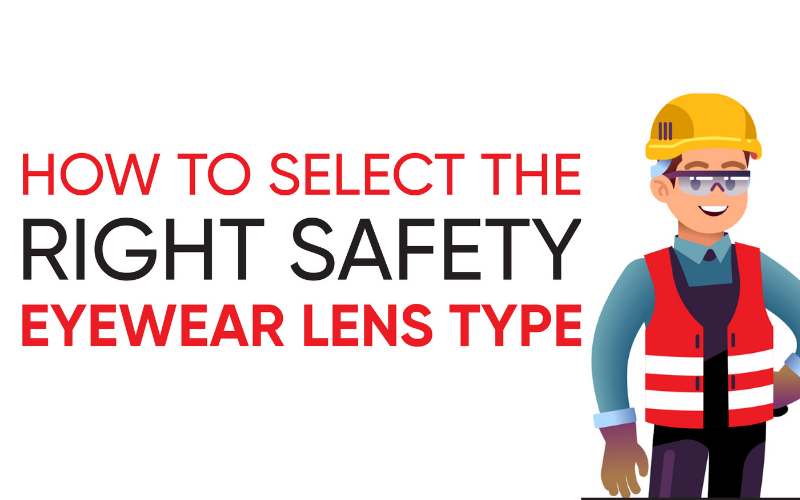
Hundreds of thousands of workers end up in emergency rooms for eye injuries that happen on the job. These injuries aren’t related to a specific job, field, or hazard, but thousands of them occur daily. Many of these injuries are minor and result in only a day or two of work lost, but there are always exceptions, and just because an injury is relatively minor doesn’t mean that you should take the risk.
As many as 90% of workplace eye injuries can be prevented with protective eyewear. A Bureau of Labor Statistics surveying workers with eye injuries had discovered that three out of five workers weren’t wearing protection at the time of their injury—and that they didn’t think it was necessary.
Hazards can occur in every home and job in the form of sharp edges, falling or flying objects, chemical splashes or thermal burns, and other sources of eye injury. If you need to do a job, or if you’re looking at replacing your existing or worn-out safety eyewear, make the kind of lens you choose a priority in your purchase decision.
ANSI Z87.1 Certification
Whatever other requirements you need in your eyewear lenses, your eyewear should at least meet the American National Standards Institute/International Safety Equipment Association (ANSI/ISEA) standard for eye and face protection. ANSI Z87.1 is a certification that covers several basic job hazards. Specifically, this is a workplace standard that states that the eyewear protects from impact, non-ionizing radiation, and liquid splash exposure.
Know Your Hazards
Each job and job site will have slightly different hazards. Having eye protection against low and high-velocity impacts, heat, chemicals, dust, and optical radiation is a good starting point for most jobs, as these are the most common hazards that safety glasses and safety goggles will have features for. Narrow your focus down to the specific activities you’ll be doing and those common hazards. Sometimes, you’ll need multiple pairs for different functions or convertible eyewear that can cover more than one need. For very specialized jobs, like welders and laser technicians, specific protections, and therefore, specialized eyewear will be required.Coatings and Tints
Coatings can make visibility more possible in harsh conditions. They can also make eyewear more versatile and durable. Anti-scratch coating for flying debris and anti-fog coating for jobs with varying temperatures and high humidity are among the most common types. There are also options like anti-static coatings to reduce the likelihood of particulates sticking to lenses or mirror coatings to reduce glare in outdoor environments. Coatings can be available separately or in combination with others, and they can be added to a lens or bonded to it permanently.
Tints are different from coatings, but each one serves a particular purpose. Tinted lenses provide accurate visibility in different lighting conditions as well as protection from ultraviolet or infrared light and prevention of eye strain and fatigue. You can choose clear lenses for jobs in normal working conditions or gray for some indoor applications or partial sunlight (brown lenses are similar to gray lenses). Amber lenses work for low light conditions and provide contrast. Light blue blocks glare from sodium vapor lighting common in large warehouses, and yellow tints enhance contrast, especially in low-light situations. Red enhances contrast without affecting color perception. Dark green is general-purpose, non-welding protection from glare and UV rays. Photochromatic lenses will darken in outdoor light which makes transitions from indoors to outdoors easy. There’s also eyewear with interchangeable lens tints for work done under many different light conditions.
Again, specialized jobs like welding will require special coatings and protections that the average pair of safety glasses can’t provide.
Lens Material
Most safety glasses have lenses made of plastic or polycarbonate, which can be in various frame styles and have the coatings discussed above. For many jobs, polycarbonate is the best choice: it resists scratches and impacts better than other materials and remains lightweight, so it doesn’t get uncomfortable or unwieldy at work. NXT Polyurethane, or Trivex, also offers excellent optical clarity compared to polycarbonate on its own but is quite costly. Acrylic lenses are cheap, light, and resistant to solvents but not quite as durable and lack the clarity of more expensive lenses. Optical glass was a popular choice many years ago and has great scratch resistance and clear vision, but it is also heavy, expensive, and lacks significant impact resistance.
Comfort, Fit, and Fashion
You’re more likely to wear eyewear that fits properly, looks nice, functions well, and that you feel comfortable in. These options can be achieved by choosing different frame and color options and having a variety of sizes. Ergonomics are also an extremely important consideration at work because comfortable glasses are glasses that will be worn. Where possible, safety eyewear should be breathable to avoid fogging up or becoming uncomfortably warm and damp. Opt for glasses that are as lightweight as you can get for the protection you need to make them easy to wear even while doing very strenuous work.
Other Vision Needs
If you or members of your team are over 40, reading glasses might be a requirement. There are bifocal safety glasses for people who need eye protection and help reading. There are also stick-on options that can convert regular pairs of glasses or goggles quickly and are easy to remove and reinstall on other eyewear.
For workers with prescription lenses, there are a few options. Some optometrists will carry prescription safety eyewear. There are also non-prescription safety glasses that can fit over regular glasses to protect them and your eyes on the job (and they come in the lens tints and coatings you need). There are also safety glasses with prescription inserts installed behind the main lens. However, you should avoid wearing contacts at work where eye hazards are present as contaminants, like dust, can get trapped behind the lens and cause irritation or damage to your eyes.

